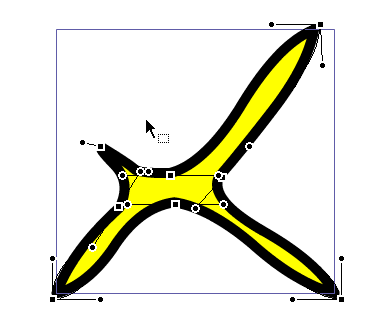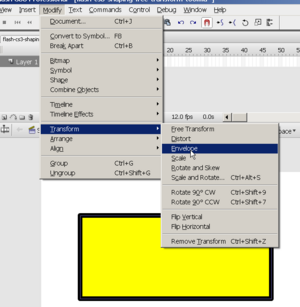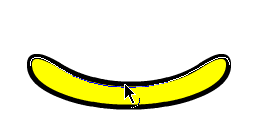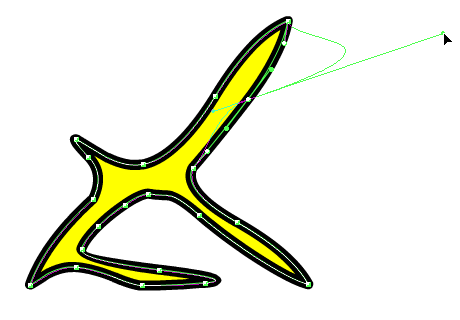Flash CS3 object transform tutorial: Difference between revisions
mNo edit summary |
m (→Overview) |
||
| Line 5: | Line 5: | ||
== Overview == | == Overview == | ||
Flash has quite powerful object transformation tools. | Flash has quite powerful object transformation tools. | ||
This article is part of some other [[Flash]] tutorials. | |||
;Learning goals: | ;Learning goals: | ||
Revision as of 02:13, 31 August 2007
<pageby nominor="false" comments="false"/>
Overview
Flash has quite powerful object transformation tools. This article is part of some other Flash tutorials.
- Learning goals
- Learn about basic Flash 9 (CS3) object transformations
- Prerequisites
- Flash CS3 desktop tutorial
- Flash drawing tutorial
- Moving on
- The Flash article has a list of other tutorials.
- Quality
- This text should technical people get going and may not be good enough for self-learning beginners. It can be used as handout in a "hands-on" class. That is what Daniel K. Schneider made it for...
- Level
- It aims at beginners. More advanced features and tricks are not explained here.
- The executive summary
- Play with all the options (at the bottom end) of the Free Transform tool. Learn how to use the envelope transform.
- Use the select tool to quickly distort an unselected object by moving the cursor close to it until it changes to curve shape, then drag
- The subselection tool allows you drag squares (distortion points) and turn/drag circles (curve control handlers)
The Free transform tool
This tool allows you to
- Scale, rotate, skew and distort
- Envelope transform
- Distort (but see the selection tool)
Envelope transforms
Let's make a designer chair.
- Step 1 - Draw a rectangle
- Do it with the rectangle tool
- Step 2 - Go into envelope transform
- Select the object first, i.e. the rectangle
- Click on the Free Transform Tool
- Select the Envelope option
- Step 3 - Transform
- Drag any little square. These are called distorsion points.
- Once you start transforming you also get curve control handles (the little circles). You can turn these in order to smoothen out curves. See the screendump just below. Or you can drag them to add new distortion (or combine both movements of course)
The Menu Modify->Transform gives you the choice of several kinds of transformations
- Select the object(s) to be transformed first
- Then select from several options
Basically it let's you all you can do with
- The Free Transform tool and its options
- The Subselection tool
The select tool
The select tool (arrow on top) strangely enough has two functions
- Select objects
- Distort objects
Default behavior of the select tool
If you click on an object or if you select it with a selection box you see this:
- A hooked cross icon
- A white circle in the middle of the selected object (or selected objects)
You then can move it around, but that's not what we are interested in right now.
Let's make a banana
Let's start with an oval drawn in object mode. See the picture above.
- Make a rounded banana with the selection tool
- First, deselect everything (including the banana), e.g. click on the gray workspace area
- Select the select tool
- Then move it close to the stroke (outline).
- When the cursor turns into a curve, then hold down the mouse and drag
Here is a result, a nice banana:
- Make sharper ends
- Copy the banana
- Again, deselect everything
- Then hold down the ALT key and slowly search around the ends of the banana.
- If you see the angle icon, then drag.
Result: two bananas of different shape:
The Subselection tool
This tool allows envelope transformations or rather fixing envelope transforms made with the Transform tool in envelope mode. Handles work like in the Envelope transform tool.
- Distortion points
The little squares are distortion points
- You can drag anywhere to change the shape of the object
- You also can drag them along the stroke before you drag them out
- You can delete these. Move the cursor over one of these and when the cursor changes shape, click first, then hit delete. This will simplify a stroke.
- Curve control handlers
The little dots are curve control handles with which you can adjust the curves in two ways:
- You can turn them to change the curve: smooth or sharpen.
- But you also can drag them to some place to distort the shape ....
- To get curve control handles click on a distortion point or move it.
If you can't see well what your are doing (I can't in 100% mode), zoom in like 200 or 400% ...
The erase tool
The erase tool allows you to carve objects. In the options / controls in the tool panel, you can change the way the erasor works.
Erasing shapes (drawn in merge mode) and graphics objects (drawn in object mode) doesn't lead exactly to the same results. When you carve an object it remains an object. When you carve a (single) shape it will divide into other shapes.
We not explain much here, better try it out ...
- Draw three nice fat ovals with a fat stroke. Two of them overlapping
- Then, select the erasor mode. This works like the paint tool
- Use Ctrl-Z to undo what you have done .... so you can try other options.
- Erasor modes
Here are the modes:
- Erase normal: Will erase as you paint
- Erase fill: Will only erase fills (paint)
- Erase lines: Will only erase strokes (lines, contours of objects)
- Erase selected fills: Will only erase fills that you have selected (hold down the SHIFT key to select several)
- Erase inside: Will erase fills inside an object if you start erasing inside the object.
- The faucet
- Will kill any shape on which you click. It makes a distinction though between the stroke and the fill of an object.
- Erasor shape
- You can select different sizes of circles and rectangles
- Use rectangles to carve off rectangles and circles to carve of round stuff.





